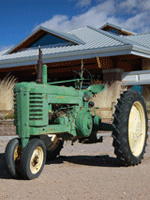
Dickson, LanaAboutBriefly discusses her personal history. The majority of the interview describes her involvement with the establishment of the New Mexico Farm and Ranch Heritage Museum.
Abstract
Tape 1, Side A
Lana Houser Dickson is the acting executive director of the New Mexico Farm and Ranch Heritage Foundation [NMFRHF]. Dickson grew up on a cow/calf ranch in north Texas, which she stills owns. She worked on her grandmother's dairy when she was young. Her grandfather farmed. She has a degree from East Texas State University in English, and a second degree from New Mexico State University in Mass Communications. She married a research scientist and they came to Las Cruces in 1963. At the time of the interview, she was head of public relations for the New Mexico Department of Agriculture. She became involved with the New Mexico Farm and Ranch Heritage Museum project in 1980 while working for Dr. Wm. P. Stephens, New Mexico Department of Agriculture, as well as Dr. Gerald Thomas, President of New Mexico State University at that time. Their first organizational meeting was February 1987. At this meeting a proposal was made that a goal should be set to build a farm and ranch museum. Dr. Stephens feared that New Mexican history was being lost: early settlers had not been interviewed, artifacts collected, and pioneering families had bit been recognized. He wanted a place to tell family histories and display furniture and ranch buildings. He wanted first to collect the names of historic properties, and then focus on a building. People were surprised at his ambition. In the first years, Dickson wrote all the letters for Dr. Stephens, the resolutions, the contact letters, and letters of appeal. In 1987, the Board of Regents, New Mexico State University at a meeting in Kenna, New Mexico, resolved to support the founding of a museum. Dr. Stephens and she went to the Texas Heritage Center at Texas Tech., to see the buildings there and learn about the administration of that museum. The group that was heading up the project soon realized they needed a Foundation that would allow people to donate and not be taxed. Eventually the museum project was placed under the Office of Cultural Affairs of the state of New Mexico. The governor then named a Museum board, separate from the Foundation board. When Dr. Stephens retired she continued her work with the Foundation under the new Secretary of Agriculture, Frank DuBois.
Tape 1, Side B
It was decided that the Museum needed to be larger than just a collection of historic properties; it should be a place for people to give things that would preserve the history of farming and ranching and offer programs to teach children about agriculture. While she wanted it to be built near the interstate to attract visitors, acreage was found for the project along the base of the Organ Mountains, east of New Mexico State University. The original drawings for the building came from James Rowland and Associates. After the architectural bids went out in 1994, the design chosen was that of an old ranch house with a portal. The Foundation Board is comprised of volunteers who raise money for the Museum, and a Museum Board appointed by the governor to set the policy for the director who is hired by the Office of Cultural Affairs. Mrs. Dickson has been running the Foundation for three years prior to this interview. They also have a program of heritage properties, farms and ranches that have been in families for fifty years or more. Money began coming in 1986 and still comes in. She set several levels of membership fees. Cargil Associates developed an elaborate mechanism for fund raising. But that was not successful because you have to have a core base to raise money and that wasn't in place at that time.
Tape 2, Side A
There were Museum name and logo "wars." Finally they chose as a logo a drawing by Bob Blum, which is the farmer on the tractor in the field and he's dreaming of a horseman in the sky who is chasing the devil bull. Dickson considers the Museum to have been Dr. Stephens' project; he was the driving force behind it. She feels that the ten-year time period between the inception and actuality of the Museum was about right. The Museum should be finished in May of 1997. She has confidence in the Museum staff. The biggest challenge is always money. She feels that the museum must continue to have changing exhibits, a good restaurant, educate children to the importance of agriculture in the United States, and be well advertised. |

